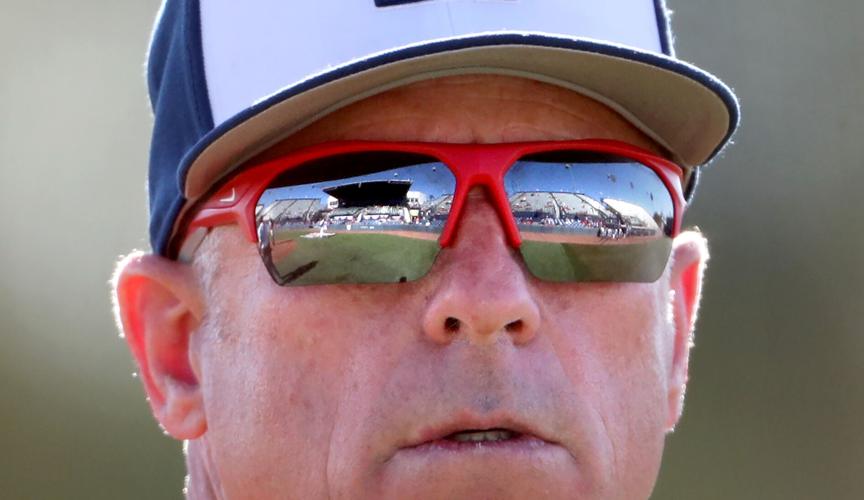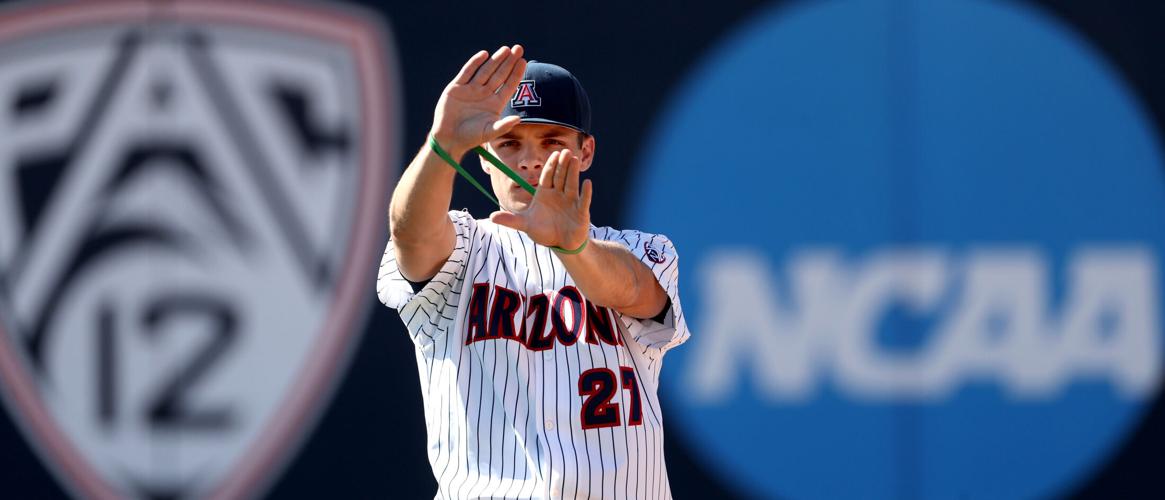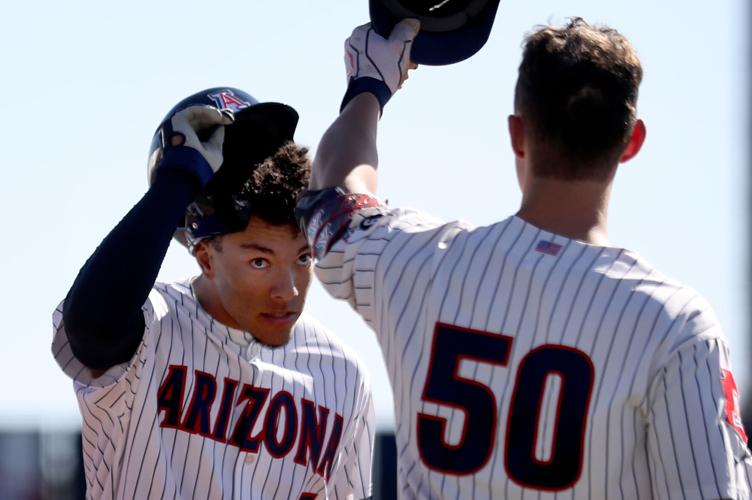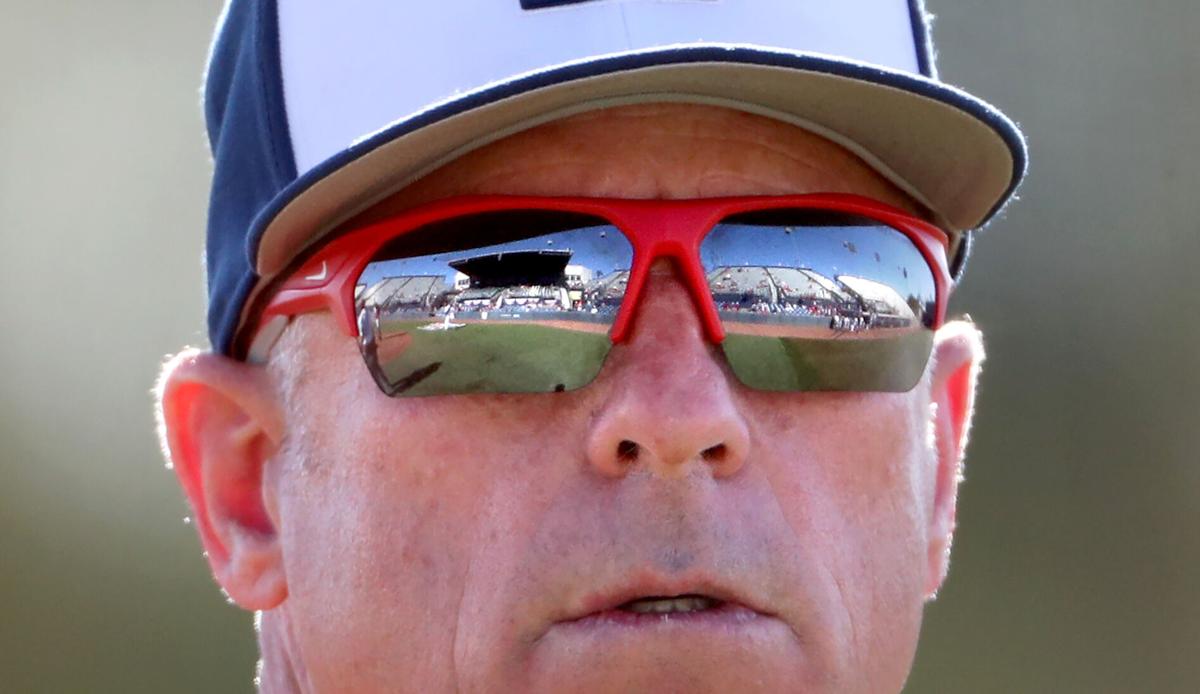Nik McClaughry and Daniel Susac were discussing freshman right-hander Josh Randall’s fastball. McClaughry, Arizona’s veteran shortstop, mentioned that Randall’s stuff “plays up.” Susac, the Wildcats’ catcher, has both hit against and caught Randall. Susac clarified what McClaughry meant.
“His spin rate’s a little higher,” Susac said of Randall. “So the ball’s a little heavier on the bat/glove.”
Spin rate. Susac opened his explanation using one of the buzziest terms in baseball. He was speaking the language of the modern game.
Spin rates, launch angles and exit velocities have become commonplace in the vocabulary of MLB, where data and analytics (an oft-used and oft-misconstrued word) have infiltrated the sport. They are no longer the exclusive purview of the pros.
The technological revolution has hit college baseball. Arizona is among a growing number of schools that have invested thousands of dollars in high-speed cameras, software programs and other tools to put their players in the best positions — literally, in the case of defensive shifts — to succeed.
UA athletic director Dave Heeke said his department endeavors to do “everything we can” to support its programs “so they can be nationally competitive.” Arizona reached the College World Series last season and is ranked in the top 15 in most preseason polls.
First-year UA coach Chip Hale said he was “shocked” at how much technology and data are available on the college level, adding that his staff has “exactly the same ability with video and scouting” that major-league staffs have. As someone who watched the game evolve over his 20-plus years as a minor- and major-league coach and manager, Hale has accepted what baseball has become. As Tom Verducci wrote in a 2019 piece for Sports Illustrated: “Technology is changing how players learn, how coaches coach, how managers manage, how front offices evaluate and how teams compete.”
“It’s part of the game,” said Hale, whose team opens the season Friday against Kansas State at the State Farm College Baseball Showdown in Arlington, Texas. “And if you’re not willing to move with the game, then you’re not going to be in it long.”
Although technology is becoming more sophisticated, and data more detailed, both have their limits. Pitchers still have to execute under pressure. Batters still have to strike a small white ball hurled between 85 and 100 miles per hour. No matter how high your exit velocity might be, Hale said, “it doesn’t mean you’re gonna get a hit.”
Neither participant in pitcher-batter duel wants to have too much information floating around in his head. So how do you find the right balance between technology and gut feel, between analytics and instincts? That’s one of the tasks Hale and his staff have undertaken since last summer.

Arizona Wildcats pitcher Dawson Netz does his pre-game band workout as the team gets ready for Saturday's meet the team scrimmage at Hi Corbett Field. Analytics can help pitchers with everything from spin rate to the shape of their pitches.
Visual feedback
Arizona has utilized TrackMan at Hi Corbett Field since the 2020 season. TrackMan is a three-dimensional doppler radar system that measures the velocity, spin rate and trajectory of thrown and batted balls. It also reveals, in real time, whether a pitch truly crossed the strike zone. Others who use it in the Pac-12 include Oregon, Oregon State, USC and Washington State.
Arizona’s growing technological toy chest also features an Edgertronic high-speed video camera, which can capture images of a pitcher’s throwing motion and release at greater than 1,000 frames per second; Rapsodo, a pitch-tracking device that charts spin rates, degrees of break and other minute metrics; and TruMedia, an analytics platform that, according to its website, enables teams to “access video, filter and visualize traditional statistics and tracking data, and build advance scouting reports.”
Last year, Mississippi State became the first college team to use TruMedia. The Bulldogs won the CWS.
“It was pretty good for them,” Hale said.
All that fancy tech seems cool. And complex. How can it help the Wildcats become better baseball players?
Pitching coach Dave Lawn said it’s beneficial to have visual feedback and data to support what in the past might have been classified as mere observations.
“We always used to go, ‘Hey, you’re getting on the side of your slider,’” Lawn said. “Now we have a camera that’s 50 billion frames per second that can actually show it. So now you’re telling them, they’re feeling it, they’re seeing it.”
Armed with that information, the pitcher can try to modify his release. He then can view his spin rate and vertical break to see if the change had the desired effect.
Analytics prompted right-hander Trevor Long to alter his arsenal. The data showed that Long’s slider and curveball had the same shape. The curve just happened to be slower — and got hit harder.
“So now I can say, ‘Trevor, what if we just went with the slider? And here’s why,’” Lawn said.
For hitters, one of the primary uses of TrackMan and other tools is strike-zone recognition. Data can provide answers to at least two critical questions, according to UA hitting coach Toby DeMello: “Are you swinging at the right pitches in the zone? Are you taking the right pitches out of the zone?”
The data also can reveal whether a batter’s swing is too steep — or not steep enough. A slugger like Susac will want to get under the ball more and generate loft. That doesn’t work for a contact hitter like McClaughry.
“If I’m getting under the ball a lot,” he said, “I can just know that, ‘OK, I need to stay on top of the ball and drive the ball through the infield.’”
That information gives McClaughry something to work on — during practice. It’s not something he should be thinking about when he steps to the plate in a game.

Arizona’s Chase Davis, left, gets a helmet bump from Cameron LaLiberte after hitting a homer in the first inning of Saturday’s scrimmage. He belted three homers in the intrasquad game.
Keeping it simple
Tyler Coolbaugh, Arizona’s director of player development, was talking to DeMello recently about the fine line between using analytics and “being a baseball guy.”
“We have all this data,” Coolbaugh said. “We can get as deep as we want on an opposing pitcher. How are we going to make sure that we don’t overwhelm these kids?”
The goal in putting together scouting reports is to compile all the information ... then boil it down into its simplest form. How might that work?
Coolbaugh offered an example. Say an opposing pitcher has a 90-mph fastball with a high spin rate and a big-breaking curveball.
“We could really do a deep dive and say, ‘This guy’s got X amount of horizontal movement, X amount of vertical movement; he’s got this kind of spin rate,’” Coolbaugh said. “But that’s a lot for a player to understand. So ... maybe every pitcher’s gonna have a nickname. A guy with a high spin rate (and a) good breaking ball, he may just be a ‘Johnny.’ And that simplifies it for them: ‘OK, I understand what this guy is gonna do.’”
Coolbaugh saw how prevalent analytics were becoming when his father, Scott, served as the hitting coach for the Oklahoma City Dodgers in 2019. The Los Angeles Dodgers spent more on research and development — about $20 million — than any MLB team at that time, according to Verducci’s reporting. Tyler Coolbaugh said the Texas Rangers, for whom he worked last year, had all of their minor-league teams utilize defensive shifts based on hitters’ statistical tendencies because that’s what the big-league club was doing.
If college players with pro aspirations are getting access to the same kind of data and technology, it can only help them in the future. They’re learning the language.
“It’s beneficial to expose these kids to the new tech, the new analytics, the new way,” Coolbaugh said. “We want them to be ready for the next level and have these tools available so that when they get there, they’re not surprised by anything.”







